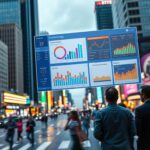Did you know that nearly every online ad relies on artificial intelligence for real-time targeting and placement? This technology is reshaping how businesses approach advertising, making campaigns more efficient and effective than ever before.
Artificial intelligence is transforming traditional advertising into a data-driven process. By analyzing vast amounts of information, it helps businesses reach their audiences in real-time across multiple platforms. This ensures your message lands in front of the right people at the right moment.
Companies like Macro Webber are leading the charge in using AI-driven performance marketing to drive revenue. Their expertise highlights the importance of integrating advanced technologies to enhance marketing strategies and achieve measurable growth.
In this article, you’ll discover key technologies, optimization techniques, and real-world case studies. Learn actionable strategies to elevate your advertising campaigns and stay ahead in the competitive marketing landscape.
Key Takeaways
- Artificial intelligence is essential for modern advertising.
- AI transforms traditional methods into data-driven processes.
- Real-time audience targeting boosts campaign effectiveness.
- Integrating AI enhances marketing performance and revenue growth.
- Macro Webber excels in AI-driven performance marketing.
Introduction to AI in Advertising
AI is revolutionizing how brands connect with their audiences online. By analyzing vast amounts of datum, it enables smarter decision-making and precise targeting. This technology is no longer a luxury—it’s a necessity for staying competitive in today’s fast-paced digital world.
Why AI Is a Game Changer Today
Artificial intelligence transforms traditional advertising by automating complex processes. It analyzes datum in real-time, ensuring your message reaches the right user at the right moment. Without AI, advertisers struggle to keep up with the speed and scale of modern campaigns.
AI also powers content creation, generating creative assets tailored to specific audiences. It optimizes budgets and even monitors competitor strategies, giving brands a significant edge. Companies like Macro Webber leverage these capabilities to drive measurable growth and revenue.
Setting the Context in the Present Digital Landscape
In today’s digital landscape, social media and other platforms are flooded with information. AI helps cut through the noise by delivering personalized experiences. For example, natural language processing ensures ads resonate with audiences on a deeper level.
Marketers face challenges like ad fraud and inefficient targeting. AI addresses these issues by detecting anomalies and optimizing campaigns in real-time. With tools like predictive analytics, brands can achieve an ROI of up to 250%, according to recent studies.
As you explore this article, you’ll uncover how AI-driven strategies can elevate your advertising efforts. From audience targeting to content distribution, the possibilities are endless. Stay tuned to learn how Macro Webber leads the way in this transformative space.
The Role of AI Systems in Enhancing Ad Distribution Strategies
Modern advertising thrives on precision, and artificial intelligence delivers just that. By leveraging advanced technologies, businesses can ensure their campaigns reach the right audience at the right time. This section explores how machine learning and data-driven strategies are transforming the advertising landscape.

Defining AI in the Advertising Realm
Artificial intelligence in advertising refers to the use of algorithms and tools to analyze data and automate decision-making. It helps marketers understand customer behavior, predict trends, and optimize campaigns. For example, Macro Webber uses AI to create personalized ad experiences that drive engagement and conversions.
AI isn’t just about automation—it’s about enhancing human creativity. By processing vast amounts of datum, it provides actionable insights that guide marketing strategies. This synergy between technology and creativity is what sets successful campaigns apart.
How Machine Learning and Data Drive Decisions
Machine learning plays a crucial role in modern advertising. It analyzes historical and real-time data to identify patterns and make predictions. For instance, it can determine which ad variations perform best and allocate budgets accordingly. This ensures every dollar spent delivers maximum ROI.
One practical example is the use of algorithms to predict customer behavior. By analyzing past interactions, AI can recommend products or services that align with individual preferences. This level of personalization boosts engagement and drives conversions.
“AI-powered tools are revolutionizing how we approach advertising, making campaigns more efficient and effective than ever before.”
Companies like Macro Webber are at the forefront of this transformation. Their commitment to using cutting-edge technology ensures their clients stay ahead in the competitive advertising space. As you’ll see in the next section, specific AI technologies are further enhancing these strategies.
Key AI Technologies Transforming Ad Strategies
Cutting-edge technologies are reshaping how ads are created and delivered. These tools enable businesses to craft personalized, data-driven campaigns that resonate with audiences. Let’s explore the innovations driving this transformation.
Natural Language Processing and Neural Networks
Natural language processing (NLP) is revolutionizing ad copy creation. It analyzes text to generate compelling messages tailored to specific audiences. For example, NLP can craft headlines that grab attention or write product descriptions that drive conversions.
Neural networks, a subset of machine learning, process language and images to create engaging ad creative. They identify patterns in datum, helping marketers understand what works best. This ensures every ad resonates with its intended audience.
Computer Vision and Deep Learning
Computer vision analyzes visual content to enhance storytelling in ads. It can identify objects, scenes, and even emotions in videos, making campaigns more impactful. For instance, it ensures visuals align with brand messaging and audience preferences.
Deep learning takes this a step further by uncovering insights from vast datasets. It helps companys optimize ad placements and improve targeting. By leveraging these technologies, businesses can achieve more effective engagements with their audience.
These tools not only streamline processes but also provide a competitive edge. By integrating them into your strategy, you can elevate your campaigns and drive measurable results.
Optimizing Advertising Budgets and Performance
Maximizing advertising budgets is now easier with advanced technologies. By leveraging real-time datum, businesses can ensure every dollar spent delivers maximum value. This approach not only improves performance but also enhances overall campaign efficiency.

Real-Time Optimization Through AI
Real-time optimization is a game-changer for modern advertising. Machine learning analyzes datum instantly, allowing for dynamic adjustments to ad placements and targeting. This ensures your message reaches the right customer at the right time.
Predictive analytics plays a crucial role in this process. By forecasting trends and behaviors, it helps allocate budgets to high-performing segments. This leads to improved conversion rates and lower acquisition costs.
“Automated budget optimization ensures campaigns are always running at peak efficiency.”
Companies like Macro Webber use proprietary tools to drive revenue through intelligent budget allocation. Their strategies focus on reallocating resources dynamically, ensuring every campaign delivers measurable results.
Case studies show that businesses using these techniques see significant improvements in performance. For example, some report a 30% reduction in wasted ad spend and a 20% increase in ROI. These metrics highlight the practical benefits of integrating advanced technologies into your advertising strategy.
As you prepare to explore creative generation in the next section, remember that optimizing budgets is just the first step. Combining it with innovative tools and strategies ensures your campaigns stay ahead in a competitive landscape.
Generating Ad Creative and Copy with AI
Artificial intelligence is reshaping how brands craft and deliver ad creative and copy. By automating the creation process, it allows marketers to focus on strategy while technology handles the heavy lifting. This approach ensures your message is both compelling and context-sensitive.
Leveraging NLP for Compelling Copywriting
Natural language processing (NLP) plays a pivotal role in generating persuasive ad copy. It analyzes vast amounts of datum to craft messages that resonate with specific audiences. For example, NLP can generate headlines that grab attention or write product descriptions that drive conversions.
One of the key benefits is rapid testing of multiple creative variants. AI can produce dozens of ad variations in minutes, allowing marketers to identify the most effective ones quickly. This speeds up the creation process and improves campaign performance.
- Automates the creation of ad creative and copy.
- Uses NLP to generate context-sensitive messages.
- Enables rapid testing of multiple creative variants.
- Fine-tunes AI-generated content with human oversight for authenticity.
- Improves speed and scale in creative tasks.
Companies like Coca-Cola and Spotify have successfully implemented these techniques. Coca-Cola uses AI to analyze social media trends, ensuring their ads align with cultural moments. Spotify personalizes ad content based on users’ listening habits, delivering relevant messages at the right time.
“AI-driven creative processes not only save time but also enhance the authenticity and relevance of ad campaigns.”
By adopting AI-driven creative processes, brands gain a significant competitive edge. They can produce high-quality content at scale, ensuring their campaigns stand out in a crowded digital landscape.
Enhancing Audience Targeting and Segmentation
Precision in reaching the right audience is now achievable with advanced tools. In a crowded digital marketplace, standing out requires more than broad messaging. It demands personalization and data-driven strategies to connect with specific groups effectively.

By leveraging rich datum, businesses can create hyper-personalized experiences. This approach ensures your campaign resonates with the right customer at the right time. Companies like Macro Webber excel in this space, using cutting-edge technologies to refine their strategies.
Personalizing Customer Experiences
Personalization is no longer optional—it’s expected. AI-driven tools analyze user behavior to craft tailored messages. For example, an apparel brand saw a 60% increase in conversion rates by implementing algorithm-based targeting.
These tools also predict ad responsiveness, ensuring your campaign delivers maximum impact. By understanding individual preferences, you can create content that feels relevant and engaging. This level of personalization builds trust and drives loyalty.
Data-Driven Targeting Strategies
Data is the backbone of modern targeting. AI analyzes vast datasets to identify patterns and segment audiences effectively. For instance, an eCommerce leader achieved a 30% boost in click-through rates by refining their segmentation approach.
Real-time adjustments based on performance data further optimize results. This ensures your campaign remains agile and responsive to changing behaviors. With tools like predictive analytics, you can allocate resources to high-performing segments, maximizing ROI.
“AI-driven targeting ensures your message reaches the right people, at the right time, with the right content.”
By adopting these strategies, businesses can achieve superior ad performance. Macro Webber’s expertise in this area highlights the transformative power of data-driven targeting. Start refining your approach today to stay ahead in the competitive advertising landscape.
Utilizing AI for Content and Visual Distribution
Strategic content distribution is now more efficient with advanced technologies. By leveraging datum, businesses can ensure their content reaches the right audience at the right time. This approach maximizes engagement and drives measurable results.
AI-powered tools analyze user behavior across multiple channels. This ensures your content is delivered where it will have the most impact. For example, Macro Webber uses these techniques to optimize media placements and boost campaign performance.
Automated Content Optimization Techniques
Automation simplifies the process of distributing content across channels. AI analyzes datum to determine the best timing and format for each piece. This ensures your content resonates with its intended audience.
One key technique is categorizing content based on user preferences. AI identifies patterns in behavior, allowing for tailored delivery. For instance, Netflix uses this approach to recommend shows, increasing viewer engagement.
Another method involves adjusting content formats for specific media platforms. AI ensures visuals and text are optimized for each channel, enhancing overall performance. This level of precision is critical for modern marketing strategies.
“AI-driven distribution ensures your message reaches the right audience, at the right time, with the right format.”
Companies like Spotify use AI to curate personalized playlists, boosting user satisfaction. By adopting similar strategies, your company can achieve greater reach and engagement. Macro Webber excels in this area, using cutting-edge tools to drive results.
Efficient channel management is another benefit of AI. By analyzing performance datum, it dynamically adjusts strategies to maximize ROI. This ensures your campaigns remain agile and effective in a competitive landscape.
Integrating AI with Programmatic Advertising
Programmatic advertising has become a cornerstone of modern marketing, thanks to its ability to automate and optimize ad placements. By combining real-time bidding with advanced technologies, businesses can ensure their campaigns reach the right customers efficiently. This approach not only saves time but also maximizes ROI.

At its core, programmatic advertising uses algorithms to automate the buying and selling of ad space across various platforms. These algorithms analyze vast amounts of datum to make split-second decisions, ensuring ads are placed where they’ll have the most impact. This level of precision is unmatched in traditional methods.
Real-Time Bidding and Audience Insights
Real-time bidding is a game-changer in programmatic advertising. It allows advertisers to bid on ad space in milliseconds, ensuring their campaigns are seen by the right audience at the right time. This process is powered by machine learning, which continuously analyzes datum to optimize bids and placements.
One of the key benefits is the ability to gain actionable insights about your audience. AI tools analyze user behavior across platforms, providing a deeper understanding of preferences and habits. For example, Macro Webber uses these insights to refine targeting strategies, ensuring ads resonate with specific customer segments.
“AI-driven programmatic advertising ensures your message reaches the right people, at the right time, with the right content.”
These technologies also improve budget management. By analyzing real-time performance data, AI can reallocate resources to high-performing campaigns. This dynamic approach reduces wasted ad spend and boosts overall efficiency. Companies leveraging these tools report significant improvements in ROI and engagement.
For instance, a recent study found that businesses using AI-powered programmatic advertising saw a 30% reduction in wasted ad spend. Additionally, campaigns optimized with machine learning achieved a 20% increase in conversion rates. These results highlight the transformative power of integrating AI with programmatic strategies.
As the market for AI in programmatic advertising continues to grow, businesses must adopt these technologies to stay competitive. Macro Webber leads the way, using cutting-edge algorithms and datum-driven insights to drive revenue and enhance campaign performance. Start integrating these strategies today to elevate your advertising efforts.
Case Studies and Real-World Examples
Real-world examples show how advanced technologies are transforming advertising campaigns. By leveraging data-driven strategies, businesses achieve remarkable results. This section dives into success stories and actionable insights you can apply to your own efforts.
Success Stories from Leading Brands
HOLT CAT, a heavy equipment dealer, used advanced tools to optimize their campaigns. By analyzing datum, they achieved a 40% increase in conversion rates. Their success highlights the power of algorithm-driven decision-making.
Vanguard, a financial services company, implemented AI-powered strategies to enhance their marketing efforts. They saw a 30% boost in ROI by personalizing ad content. This example demonstrates the impact of tailored messaging.
An eCommerce leader used social media integration to refine their campaigns. By leveraging real-time datum, they reduced wasted ad spend by 25%. Their results underscore the importance of dynamic optimization.
“AI-driven strategies ensure campaigns deliver measurable results, from increased engagement to higher ROI.”
Takeaways for Your Ad Campaigns
These success stories offer valuable lessons for your business. Here are key takeaways to elevate your campaigns:
- Use datum to segment your audience effectively.
- Leverage algorithms for real-time decision-making.
- Integrate social media platforms for broader reach.
- Test multiple creative variants to identify top performers.
- Monitor performance metrics to optimize budgets dynamically.
Companies like Macro Webber mirror these strategies, achieving impressive results. Their innovative approach combines insights and advanced tools to drive success. By adopting similar methods, you can enhance your campaigns and stay competitive.
Start implementing these recommendations today to see measurable improvements. Whether it’s boosting conversion rates or optimizing budgets, the right strategies make all the difference.
Leveraging AI Tools & Platforms for Ad Success
In today’s fast-paced digital world, leveraging advanced tools is essential for advertising success. These platforms empower businesses to create, optimize, and distribute campaigns with precision. By integrating cutting-edge technology, you can achieve measurable results and stay ahead in the competitive marketing landscape.

Overview of Cutting-Edge AI Advertising Tools
Modern advertising relies on tools like Persado, Emotiva, and Pathmatics. These platforms use machine learning to analyze datum and generate optimized ad creatives automatically. For example, Persado crafts compelling copy by analyzing language patterns, while Pathmatics provides insights into competitor strategies.
Key features of these tools include advanced analytics, real-time optimization, and automation. They help you understand customer behavior, predict trends, and allocate budgets efficiently. By leveraging these capabilities, you can maximize ROI and reduce wasted ad spend.
“AI-driven platforms ensure your campaigns are always running at peak efficiency, delivering measurable results.”
How Macro Webber Helps Drive Revenue with AI
Macro Webber integrates proprietary technology to enhance advertising strategies. Their tools analyze vast amounts of datum to deliver personalized experiences. This approach ensures your message resonates with the right customer at the right time.
One of their standout platforms uses machine learning to optimize ad placements dynamically. This ensures every dollar spent delivers maximum impact. Clients report significant improvements in engagement and conversion rates, highlighting the effectiveness of these recommendations.
To evaluate and choose the right technology, consider your campaign goals and customer needs. Look for tools that offer scalability, ease of use, and robust analytics. Macro Webber’s expertise in this area ensures you stay ahead in the ever-evolving advertising landscape.
Strategies for Future-Proofing Your Advertising Efforts
Staying ahead in advertising requires strategies that adapt to rapid changes. By investing in robust infrastructure and embracing continuous testing, you can ensure your campaigns remain effective and efficient. This approach not only addresses current challenges but also prepares you for emerging trends.
Investing in Robust AI Infrastructure
Scalability is key to future-proofing your efforts. Investing in advanced tools and platforms ensures your campaigns can handle increasing demands. For example, Macro Webber uses cutting-edge algorithms to analyze datum and optimize ad placements dynamically.
These platforms not only improve efficiency but also provide actionable insights. By leveraging machine learning, you can predict trends and allocate resources effectively. This ensures your strategy remains agile and responsive to changing behaviors.
Continuous Testing and Optimization for Ongoing Success
Iterative improvements are essential for long-term success. Continuous testing allows you to refine your strategy based on real-time datum. For instance, A/B testing helps identify the most effective ad variations, boosting effectiveness and ROI.
Flexibility is another critical factor. By adjusting your approach to align with new technologies, you can overcome challenges and seize opportunities. Macro Webber’s commitment to innovation ensures their clients stay ahead in the competitive landscape.
“Future-proofing your advertising efforts requires a blend of robust infrastructure and adaptive strategies.”
By adopting these strategies, you can build campaigns that withstand market shifts. Focus on scalability, continuous improvement, and flexibility to achieve sustainable growth. Macro Webber’s expertise in this area highlights the transformative power of forward-thinking strategies.
Conclusion
Artificial intelligence is reshaping how businesses connect with their audiences, delivering personalized experiences at scale. By leveraging advanced tools and platforms, you can optimize ad performance and boost conversion rates. From natural language processing to programmatic advertising, these technologies ensure your message reaches the right customer at the right time.
Key insights show that AI-driven strategies improve customer engagement and maximize ROI. For example, Macro Webber uses cutting-edge capabilities to refine ad placements and enhance social media campaigns. Their success highlights the transformative power of integrating artificial intelligence into your marketing efforts.
Take the next step to future-proof your advertising. Adopt AI-enhanced strategies to stay ahead in a competitive landscape. With the right tools, you can create impactful campaigns that drive measurable results. Start today and unlock the full potential of artificial intelligence for your company.



